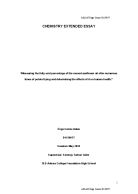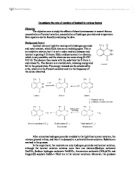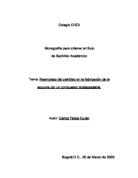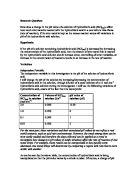Chemistry thermo lab, Hess's Law.
________________ ________________ ________________ ________________ ________________ Hess’s Law Lab ________________ Qusai Al Omari ________________ Introduction: In this lab, we will be determining the change in enthalpy for the combustion reaction of magnesium (Mg) using Hess’s law. Procedure: . React about 100 mL of 1.00 M hydrochloric acid with 0.80 g of MgO. Note the change in temperature and any qualitative data. 2. React about 100 mL of 1.00 M hydrochloric acid with 0.50 g of Mg. Note the change in temperature and any qualitative data. Raw Data: Quantitative: Reaction, trial Mass (± 0.01 g) Initial temperature (± 0.1⁰ C) Final temperature (± 0.1⁰ C) Volume of HCl (± 0.05 mL) Reaction 1, Trial 1 0.80 22.0 26.9 100.00 Reaction 1, Trial 2 0.80 22.2 26.9 100.00 Reaction 2, Trial 1 0.50 21.6 44.4 100.00 Reaction 2, Trial 2 0.50 21.8 43.8 100.00 Qualitative: . Hydrochloric acid is colorless and odorless 2. Magnesium tape is shiny after cleaning it from oxidants, increasing its purity. 3. In both reactions, the solution became bubbly. 4. There was a strong odor from the reaction. Data Processing: Trial 1: Reaction 1: First, we have to calculate the ΔT by subtracting the final temperature by initial temperature: . 2. 3. Now we calculate the mass of the solution, assuming it has the density as water: 1. 2.
The chemistry of atmospheric and water pollution.
Human activity has caused changes in the composition and the structure of the atmosphere. Chemists monitor these changes so that further damage can be limited. Point 4.1 – Describe the composition and layered structure of the atmosphere. The atmosphere contains 4 distinct layers. They are: troposphere, stratosphere, ionosphere (which is made up of two layers called mesosphere and thermosphere). Troposphere: The troposphere is the layer which is closest to the earth’s surface. It is approximately 0-15km above earth’s surface. The thermosphere contains 3 main gases. Nitrogen is the most abundant gas at 78% (by volume). The nitrogen is part of the nitrogen cycle. The second most abundant gas is oxygen (21%) which is necessary for the process of respiration in living things. Argon is next at 0.9% and other gases such as carbon dioxide, Ne, He and variable amounts of water vapour are present. As altitude increases, the temperature decreases (because of low pressure). Here is where all the weather takes place. Stratosphere: The stratosphere lies above the troposphere. It is approximately 15-50km above the earth’s surface. Important gases in this layer include nitrogen, oxygen and especially ozone. In the upper stratosphere there is the ozone layer. Temperature rises as altitude rises in this layer because particles (e.g. ozone) in the stratosphere absorb harmful U.V.
IB chemistry revision notes
TABLE OF CONTENTS Table of Contents 1 Atomic Theory 3 The Electromagnetic Spectrum 3 Atomic Emission Spectra 3 Explanation for the Emission spectra 3 Subatomic Particles 4 Atomic Numbers 4 Mass Numbers 4 Isotopes 4 Calculating RAM by example - Lead (Pb) 4 Solutions 4 Periodicity 5 Elements 5 Physical Properties 5 Atomic and Ionic Radii in the Periodic Table 5 Electronegativity (Pauling's) 6 Electronegativity in the Periodic Table 6 Ionisation Energy 6 Successive Ionization Energies 7 Melting Points 7 Chemical Properties 8 Use of Standard Electrode Potentials 8 Test for Halide Ions 9 Trends across the Third Period 9 Bonding 9 Ionic Bonding 9 Covalent Bonding 10 V.S.E.P.R. Theory 11 Intermolecular forces 12 Metallic Bonding 13 Solubility 13 Transition Metals 13 States of Matter 14 Solids 14 Liquids 14 Gases 14 Endothermic Processes 14 Exothermic Processes 15 Diffusion 15 Kinetic Theory 15 Maxwell-Boltzmann Energy Distribution Curves 15 Energetics 16 Energy Profile of Reaction 16 Hess' Law 16 Enthalpies of Reactions 16 Entropy Change, 17 Kinetics 18 Rate of Reaction 18 Collision Theory 18 The Rate Determining Step 18 Catalysts 19 Equilibrium 19 Dynamic Equilibrium 19 The Equilibrium Constant 19 Le Chatelier's Principle 19 Factors Affecting the Position of Equilibrium 19 Catalysts 20 The Häber Process (Production of
Measuring the fatty acid percentage of the reused sunflower oil after numerous times of potato frying and determining the effects of it on human health.
ASLAN Özge Cemre D129077 CHEMISTRY EXTENDED ESSAY “Measuring the fatty acid percentage of the reused sunflower oil after numerous times of potato frying and determining the effects of it on human health.” Özge Cemre Aslan D1129077 Session: May 2010 Supervisor: Serenay Tarhan Güler TED Ankara College Foundation High School ASLAN Özge Cemre D129077 TABLE OF CONTENTS Abstract Introduction…………………………………………………………………………………….1 Research Question……………………………………………………………………2 Background Information………………………………………………………………3 Chemistry of Fatty Acids and Oils Information on Effects of Fatty Acids and Oils Experiment Materials…………………………………………………………………………………6 Preparation of KOH and phenolphthalein…………………………………………… 7 Method……………………………………………………………………………………8 Preparing the sunflower oil……………………………………………………………9 Determining the percentage of free fatty acids in the sunflower oil by acid-base titration…………………………………………………………………………………………10 Data
To determine the standard enthalpy of formation of Magnesium Oxide using Hess Law.
Candidate Name: Candidate Number: Page | International Baccalaureate Diploma Program (IBDP) Session: May 2015 Chemistry HL Lab Report Lab Report Title: To determine the standard enthalpy of formation of Magnesium Oxide using Hess’ Law. Criteria Assessed: * Data Collection and Processing (DCP) * Conclusion and Evaluation (CE) Candidate Name: Candidate Number: International School, Singapore AIM: To determine the standard enthalpy of formation of Magnesium Oxide using Hess’s law. INTRODUCTION: The objective of this experiment was to determine the change in enthalpy when one mole of Magnesium (Mg) reacts with half a mole of Oxygen (O2) to give one mole of Magnesium Oxide (MgO). The balanced chemical equation is as follows: Mg (s) + O2 (g) → MgO (s) ---- ΔHMgO f The reaction between Magnesium and Oxygen to form Magnesium Oxide is essentially the combustion of Magnesium and since every combustion reaction is an exothermic reaction, this reaction too is an exothermic reaction, i.e. it too will produce heat to the surroundings. In fact, the combustion of Magnesium is highly exothermic as it produces flames whose temperatures reach almost 2500oC (http://physics.stackexchange.com). At such high temperatures, a very bright white light is produced and if directly looked upon for long
Investigate the rate of reaction of luminol in various factors. The objective was to study the effects of chemiluminescence in several factors: concentration of luminol solution, concentration of hydrogen peroxide and temperature. Rate equation can be fou
Investigate the rate of reaction of luminol in various factors Objective The objective was to study the effects of chemiluminescence in several factors: concentration of luminol solution, concentration of hydrogen peroxide and temperature. Rate equation can be found by analysing the data. Background theory Luminol can emit light by reacting with hydrogen peroxide and metal catalyst, which H2O2 acts as an oxidising agent. This is an oxidation reaction, but it is not a redox reaction, because only luminol is gaining 2 O atoms. H2O2 oxidises luminol to a dianion, which is very unstable, and the electrons can move along O=CN--N-C=O. The dianion then reacts with O2, substitute the N from it, and release N2. The dianion is at excited state, releasing energy and fall to the ground state. The energy released can be calculated by e=hv, where h is the Planck's constant and v is the frequency of the colour observed. After colourless hydrogen peroxide is added to the light blue luminol solution, the mixture glowed in blue, and then it is decayed to a yellowish brown solution. Bubbles are evolved in the process. In the experiment, the reactants are only hydrogen peroxide and luminol solution, although the luminol solution contains more than one chemical(Sodium carbonate Na2CO3, Sodium hydrogen carbonate NaHCO3, Ammonium carbonate (NH4)2CO3 and Copper(II) sulphate CuSO4 * 5H2O are
Espuma a base de cscara de pia
Colegio CIEDI Monografía para obtener el título de Bachiller Académico Tema: Reemplazo del petróleo en la fabricación de la espuma por un compuesto biodegradable. Autor: Carlos Felipe Durán Bogotá D.C., 20 de Marzo de 2009 ¿Se justifica el reemplazo del uso del petróleo en la fabricación de espuma por un compuesto biodegradable, considerando los efectos ecológicos que se eliminan al reemplazo? La espuma se obtiene a través de la reacción de dos compuestos llamados isocianato y poliol. El primero aporta radicales NCO, mientras que el segundo aporta los OH para crear los poliuretanos, que después por el CO2 liberado se convierten en espumas. Este material es usado en diferentes áreas industriales y caseras, y es contaminante por ser derivado del petróleo, y porque el isocianato también tiene un nivel de toxicidad que llega a ser contaminante al medio ambiente y a los seres vivos de él. El objetivo principal es demostrar si es viable reemplazar el uso del petróleo en la producción de espuma por la cáscara de piña. Este último compuesto contiene lignina y hemicelulosa, la cual al tratarla libera grupos OH, que son los que se necesitan para que el isocianato reaccione y se obtenga el poliuretano. Los beneficios de utilizar la cáscara de piña es que se disminuiría el número de animales que son afectados por el petróleo, en especial los
Kinetics of the Acid-Catalyzed Iodination of Propanone
Name: Kayla Jackson Date: 10th of May Partner's name: Shu Ean Wong Kinetics of the Acid-Catalyzed Iodination of Propanone Introduction Research - The aim of this investigation is to calculate the values of x, y and z and hence the overall order of the reaction. Prior to proposing a possible mechanism for the reaction that is consistent with the suggested rate equation. The value of k, the rate constant will also be determined for this reaction at the temperature (room temperature) at which the experiment was conducted. The reaction between iodine and propanone involves only one coloured reagent, being that of iodine. "This immediately suggest that the reaction would be quantifiable" via colour based analysis such as that of a spectrophotometer, or merely by timing a visual analysis of the reaction and then henceforth calculate the rate from the time of the iodine to be completely reacted. Any changes in the rate of the reaction will therefore be solely due to the changes in the Iodine concentration. The order of the rate of the reaction is determine through a theory referred to as initial rates. These initial rates are used in order to measure the rate of reaction before the reactants have been completely used up. This is done by drawing a tangent from when time is equal to zero on a time verse concentration graph, prior to working out the rate from the gradient of
Acids/Bases Design Lab. How does a change in the pH value of a solution of hydrochloric acid (HCl(aq)), affect how much zinc metal is reacted with the hydrochloric acid in a one minute time frame
Research Question: How does a change in the pH value of a solution of hydrochloric acid (HCl(aq)), affect how much zinc metal is reacted with the hydrochloric acid in a one minute time frame (rate of reaction), if the zinc metal is kept as the excess reactant across all variations in pH of the hydrochloric acid solution. Hypothesis: If the pH of a solution containing hydrochloric acid (HCl(aq)) is decreased by increasing the concentration of the hydrochloric acid, then the amount of zinc metal that is reacted by the hydrochloric acid solution should increase since, controlling all other variables, an increase in the concentration of reactants results in an increase in the rate of reaction. Variables: Independent Variable: The independent variable in this investigation is the pH of the solution of hydrochloric acid. I will change the pH of the solution by increasing/decreasing the concentration of hydrochloric acid in the solution, through dilution of a stock solution of a 12 mol dm-3 hydrochloric acid solution during the investigation. I will use the following variations of hydrochloric acid, aware of the fact that it is monoprotic: Concentration of HCl(aq) in solution (mol dm-3) Volume of HCl(aq) solution (dm3) pH value of solution (pH) 2.0 0.030 -0.30 .0 0.050 0 0.1 0.300 0.01 0.500 2 For the most part, these variations and their associated pH
Enthalpy Change Design Lab (6/6)How does changing the initial temperature (19C, 25C, 35C, and 45C) of two 40.0 cm3 at 1.00 mol dm-3 solutions of KOH(aq) and HCl(aq) affect the molar enthalpy change of the neutralization reaction
Research Question: How does changing the initial temperature (19°C, 25°C, 35°C, and 45°C) of two 40.0 cm3 at 1.00 mol dm-3 solutions of KOH(aq) and HCl(aq) affect the molar enthalpy change of the neutralization reaction when the two are allowed to react in a doubled polystyrene cup? Hypothesis: If the temperature of both solutions of 1.00 mol dm-3 HCl(aq) and KOH(aq) is increased prior to the two reacting in a doubled polystyrene cup, then the molar enthalpy of the reaction between the two solutions should be greater since the reactants can fully react quicker since there is more energy in the surroundings of the KOH(aq) and HCl(aq) ions, so they will be moving faster, and will therefore result in a higher molar enthalpy change as compared to neutralization reactions of 1.00 mol dm-3 of KOH(aq) and HCl(aq) occurring at lower initial temperatures at the time of reaction. Independent Variable The independent variable in this investigation is the temperature at which both the 1.00 mol dm-3 HCl(aq) and 1.00 mol dm-3 KOH(aq) are at, at the time of the neutralization reaction between the two is being performed in a doubled polystyrene cup. The variations of temperature of the 1.00 mol dm-3 KOH(aq) and 1.00 mol dm-3 HCl(aq) that will be used in the investigation are 19°C, 25°C, 35°C, and 45°. This offers a suitable, wide spectrum of temperatures at which the reactants will











